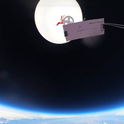Going with the flow
Which way is it heading? That has been the crucial question for both Britain’s Civil Aviation Authority and fishermen in Florida over the past two months, and the answer in both cases boils down to the same scientific issue: how well we can predict large-scale turbulent fluid flow. Fluid dynamics has never been the sexiest of disciplines, but suddenly it’s been thrust into the limelight.
Turbulence—the eddy-strewn, chaotic flow of fluids such as air and water—is notoriously one of the hardest problems in science. You can write down the equations, but solving them is a nightmare. Today it is done the hard way, by computer number-crunching, the stock-in-trade of meteorological forecasting. How volcanic ash gets dispersed depends largely on the wind patterns, which are trickier to predict than the stately movements of warm and cool fronts. And the task is complicated by the steady gravitational settling of ash, which in turn depends on its composition and size of the particles.
For its trajectory predictions of debris from the Icelandic volcano Eyjafjallajökull, the Met Office relied on a computer model developed to forecast fallout dispersal from Chernobyl. The Met Office’s scientists claim the model has done splendidly this time round, and Paul Ginoux, of the Geophysical Fluid Dynamics Laboratory in Princeton, says that, if all the input data are accurate, such models can reliably pinpoint where the ash will go to within ten miles or so. But the airline industry is unhappy about having been grounded on the basis of modelling alone, and some airlines have even conducted flights to gather data which they say challenge the computer predictions.
The industry has hardly been pro-active, however. Although the danger of flying through ash is clear—in 1982 a Boeing 747 temporarily lost the use of all four of its engines in an ash cloud from an eruption in Indonesia—there has been very little research by aircraft manufacturers or airlines to establish the safe threshold of ash concentration. And although in 1991 Australian scientists demonstrated a radar that could be fitted to aircraft to distinguish volcanic ash from normal clouds, so that pilots might steer round it, the air industry has ignored the idea. The Australian team claims that planes equipped with this device would not now need grounding.
Blowing in the wind
The oil slick from BP’s Deepwater Horizon rig has also been at the mercy of the winds, which in late May brought the thick crude onto the Louisiana coastal marshlands. Here the shortcomings of computer models were a relief: a predicted possible landfall elsewhere in Louisiana was earlier averted by a last-minute shift in wind direction.
The stakes are extremely high in this fluid-dynamic lottery. By the time Prospect hits the newsstands, we should know if, as feared, the slick has been picked up by a warm current called the Loop Current and reached the coastline of southern Florida. Understandably, everyone has been praying for weaker winds to slow the spread.
And if predicting an oil slick’s movements sounds tough, how about containing it? As we saw in this case, no strategy is guaranteed success. Some oil will simply evaporate. Some might be burned, either in open water or when it reaches a coast—although then there’s the dispersal of smoke to worry about. Oil can be skimmed from the sea surface, or broken up with the detergent-like dispersants that have been stockpiled by BP.
The oil company also tried lowering giant funnels down to the sea floor to capture oil still leaking from the drilling site. Sucking it up with a mile-long tube onto a waiting ship has been partially successful, and efforts continue.
It's raining lasers
It’s an auspicious time to be thinking about engineering the atmosphere. A Swiss team has demonstrated that infrared lasers can be used to seed cloud formations in moist air, potentially triggering rainfall. In cold, moist air in the laboratory, the lasers generated visible cloud droplets by ionising atoms in the air. Tested in the skies over Berlin, the laser increased the density of water droplets, creating mistiness invisible to the naked eye but detectable from scattered light. Seeding rain is usually attempted to moisten arid regions for agriculture and water-resource management, but rain can also “wash” some contaminants from the atmosphere. Sadly, though, it’s unlikely to get rid of troublesome volcanic ash.
Lab report
Ash and oil slicks—a fluid question
May 20, 2010











